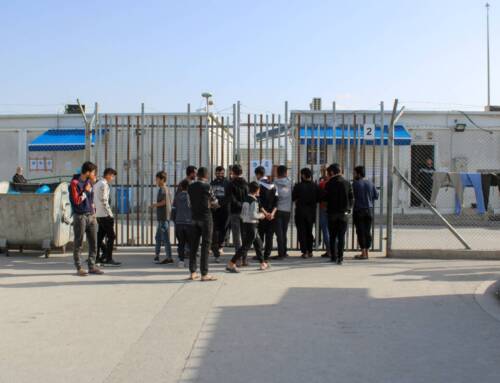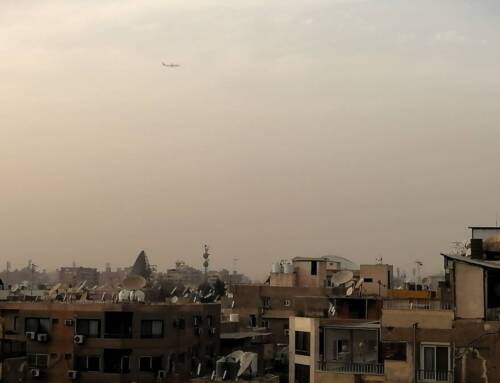As IS defeat in Deir e-Zor nears, concern turns to tribal tensions, sleeper cells
Men thought to be IS fighters leave Baghouz Fawqani with […]
14 February 2019

AMMAN: The murky outline of one corpse, maybe more, lies in the middle of a dirt crossroads. Armed men gather around. Rounds of celebratory gunfire rattle off in the background.
The video, shared by local media outlet Euphrates Post earlier this week, appears to show the aftermath of the execution of four Islamic State (IS) fighters in the eastern Deir e-Zor town of Gharaneej that reportedly took place on February 11.
According to local media reports, the four IS militants attempted to flee from IS-held Baghouz Fawqani—a small farming village on the banks of the Euphrates River that now represents the very last IS territory in Syria—before trying to make for the central Badia desert region. The militants were apprehended by local tribes in the nearby village of Gharaneej, then executed in the street.
As the Kurdish-majority Syrian Democratic Forces (SDF) are now battling the withering remains of the hardline group’s self-proclaimed “caliphate,” residents and analysts describe looming threats to local stability as well as the conspicuous presence of IS sleeper cells that could pose a threat long after the hardline Islamist group is territorially defeated.
The Kurdish-majority SDF have been battling IS for several months in a series of small towns and villages along the banks of the Euphrates River in the Deir e-Zor countryside—now the hardline group’s final territorial foothold in Syria
Backed by US-led coalition airpower, the SDF launched an offensive against the last IS pocket on September 10. For months, the on-off offensive has seen the SDF sustain large casualties, while gaining and then sometimes ceding territory to the hardline Islamists.
Human rights groups have repeatedly levelled allegations at the international anti-IS coalition for responsibility in the deaths of hundreds of civilians during regular withering bombardments from the air—with airstrikes reportedly targeting not only military installations but also civilian infrastructure including residential neighborhoods, shops and mosques.
A statement from the US-led coalition Thursday said IS fighters were “retreating and hiding amongst the local population.”
SDF battles IS as US withdrawal nears
The fight to remove IS has taken on ever more urgency in recent weeks after a shock announcement by US President Donald Trump in late December that American forces would withdraw altogether from Syria within a 30-day timeline—a point that reportedly left US allies on the ground blindsided.
That announcement has only been more confused by mixed messages from the president himself, as well as different branches of the US administration seemingly trying to backtrack on the surprise shift in policy.
“Russia, Iran, Syria & many others are not happy about the U.S. leaving…because now they will have to fight ISIS and others, who they hate, without us [sic],” Trump wrote in a Twitter post last month, despite having claimed the previous day that US forces had successfully “defeated” IS in Syria.
General Joseph Votel, head of the US Central Command, said earlier this week that US troops would be pulled out within the coming weeks.
“I think we are right on track where we wanted to be,” Votel told reporters on February 10, adding that US forces were nevertheless steering clear of “a specific timeline.”
And while the SDF’s leadership have claimed that victory over IS in Deir e-Zor could well be imminent, SDF commanders and civilians on the ground say that intensified fighting around the town of Baghouz Fawqani has seen a rump of hardline IS fighters surrounded but not yet kowtowed. Local terrain is difficult, with hundreds of IS-planted landmines scattered across exposed desert and farmland. Meanwhile, large numbers of civilians are thought to be still trapped inside the encircled IS pocket.
“Daesh is now in its final stages,” Leilawa Abdullah, spokesperson for the SDF-linked Deir e-Zor Military Council, told Syria Direct this week, using an Arabic acronym for IS. “They are trapped within a tiny area, although they are using civilians in areas under its control as human shields.”
“Our forces are opening safe corridors for the exit of civilians, to free them and transfer them to areas liberated by our forces,” Abdullah added.
According to local media activist Ammar Jassem, from the Shaitat Media Center near Baghouz Fawqani, “IS families and some of the remaining civilians have been leaving the area,” however many others have been left behind.
“There’s still a very small number of civilians left behind, as well as some IS family members as well. IS doesn’t prevent anyone from leaving, with the exception of its fighters, who flee in secret,” Jassem added.
He requested that his real name be withheld for security reasons.
However, civilians in the area now fear what may come next. Arab tribal communities in eastern Deir e-Zor are divided over the presence of the SDF, a Kurdish-majority force that seized swathes of territory from IS since 2015.
IS sleeper cells
The increasingly conspicuous presence of IS sleeper cells in the region, meanwhile, could threaten long-term stability.
“A key part of IS’ strategy in Deir e-Zor moving forward is to have a network of operatives who exist amongst the local population, who are from the local population of eastern Syria…to make it difficult for any post-IS administration to provide security and services,” said Nicholas Heras, Middle East Security Fellow at the Center for a New American Security.
Since Trump’s announcement, IS sleeper cells have seemingly become a greater threat in parts of Syria once under its control.
On January 16, IS claimed responsibility for a suicide attack in Aleppo province’s Manbij, under SDF control since 2016, that targeted a restaurant where US military personnel were meeting with SDF counterparts.
Two American servicemembers, one Department of Defense civilian and and a contractor were killed in the blast, as well as several SDF fighters and civilians.
The hardline group then attacked a US-SDF convoy near Hasakah, some 250 kilometers east of Manbij, a few days later.
In towns and cities across eastern Syria, shadowy cells of IS fighters are said to be responsible for scattered bombings and assassinations while flying checkpoints belonging to IS emerge by nightfall before militants disappear back into the shadows before sunrise.
Sleeper cells allow IS to “conduct a range of different operations,” Heras added, including assassinations of local leadership, civilians and to “harass movement in between settlements and cities throughout eastern Syria.”
“The whole point for IS is to make it difficult for anyone to claim that they have built a better order than IS did, when it controlled most of eastern Syria.”
‘Maybe the sleeper cells will return’
Residents say they fear what’s to come, as the sleeper cell attacks show few signs of abetting.
“There are many cases of assassinations and operations against the SDF that are attributed to Daesh, but in reality…they are acts of resistance to [the SDF’s] policies” by local tribes, Adel Obeid, a civilian from rural Deir e-Zor, told Syria Direct. “Either that, or they are part of tribal disputes caused by IS before it retreated.”
“And those disputes will continue after Daesh’s departure [from the area],” Obeid warned.
Eastern Syria has already seen a wave of murders and revenge attacks for abuses during the IS years, and observers suggest that the extent of violence under IS may be such that the traditional code of justice, known as al-Arf, used by the area’s tribes, could not be enough to resolve disputes peacefully.
“If there had been, for example, an honor crime, then al-Arf was usually the most dominant factor in solving such a crime,” Dr. Haian Dukhan, a researcher on Syrian tribes from the Centre for Syria Studies at the University of St. Andrews in Scotland, told Syria Direct last year.
“[But] when you consider the large-scale massacres that happened during the war, I’m afraid that al-Arf is going to be dealing with situations it has never dealt with before.”
One of the worst such instances of violence took place in Deir e-Zor province, not far from where the SDF is currently fighting to uproot IS once and for all.
In August 2014, members of the Shaitat tribe, present in Deir e-Zor province’s southeast, rebelled against IS.
IS responded by parading some 700 Shaitat men into the desert where fighters filmed themselves decapitating and gunning down tribesmen—one of the largest documented mass killings ever committed by the hardline group.
Some of the frontline positions around Baghouz Fawqani are currently manned by Shaitat tribal fighters reportedly intent on revenge for the 2014 atrocity.
And while observers expect a final push against IS in Deir e-Zor, many are skeptical that IS will disappear from eastern Syria after losing its holdout territory on the Euphrates.
“If the seed [of IS] is still present, then IS has not died,” said local administrator Khalid al-Aqla.
“Right now they’re in hibernation, sleeping. But if things don’t stabilize in Deir e-Zor…maybe these [sleeper] cells will return.”







